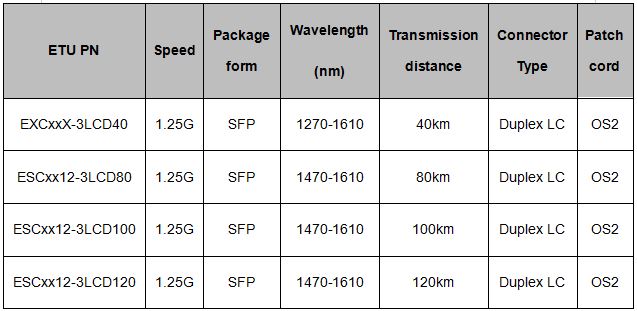
Demystifying the difference between CWDM optical modules and ordinary optical modules
The development of optical communication has driven the rapid growth of optical communication components. As one of the components of optical communication, the optical module plays a role in photoelectric conversion. There are many types of optical modules, such as SFP optical modules, SFP+ optical modules, QSFP+ optical modules, QSFP28 optical modules, CWDM optical modules, DWDM optical modules, and so on. Each type of optical module has different application scenarios and functions. Below, ETU-LINK will introduce the difference between CWDM optical modules and ordinary optical modules.

Definition of CWDM optical module
The CWDM optical module is used in the coarse wavelength division multiplexer/demultiplexer. The coarse wavelength division multiplexing(CWDM) technology is a low-cost WDM transmission technology for the access layer of the metropolitan area network. In other words, the CWDM technology is to use an optical multiplexer to multiplex optical signals of different wavelengths into an optical fiber for transmission. At the receiving end of the link, the mixed signal in the optical fiber is decomposed into different wavelength signals by optical demultiplexer and transmitted to the corresponding receiving device.
The difference between ordinary optical modules and CWDM optical modules
1. CWDM optical modules use fewer fibers than ordinary optical modules. The CWDM optical module multiplexes the original multiple signals with different wavelengths into one signal, and then transmits it to the receiving end through a single optical fiber. The receiving end demultiplexes one signal into multiple different wavelength signals and transmits it to the corresponding equipment. In contrast, ordinary optical modules usually need to use one optical fiber for one wavelength. Therefore, CWDM optical modules can effectively improve the utilization of optical fiber resources.
2. After the CWDM optical module is inserted into the switch, an optical module used in the coarse wavelength division multiplexer/demultiplexer is also needed, and the ordinary optical module can be operated directly after being inserted into the switch.
3. CWDM optical modules have a total of 18 channel wavelengths (1270-1610nm), and each channel has a wavelength interval of 20nm. The wavelengths of ordinary optical modules are usually 850nm, 1310nm, 1330nm and 1550nm.
4. As a low-cost WDM transmission technology for the access layer of the metropolitan area network, CWDM is mainly used in the telecommunications field, while ordinary optical modules are more used in the data communication field.
Application fields of CWDM optical modules
CWDM optical modules are widely used in CATV (cable television), FTTH (fiber to the home), 1G and 10G fiber channel, 100M and Gigabit Ethernet, synchronous optical network SONET OC-3 (155Mbps), OC-12 (622Mbps) and OC-48 (2.488Gbps), security and protection systems and other fields.
What are the advantages of CWDM optical modules?
(1) The equipment cost is low, which can reduce the network operation cost
(2) It can significantly improve the utilization of optical fiber resources
(3) Small size, low power consumption, good flexibility and scalability
Common types and models of CWDM optical modules
(1) CWDM SFP optical module
CWDM SFP optical module is an optical module that combines CWDM technology. Similar to the traditional SFP, the CWDM SFP optical module is a hot-swappable input/output device that is inserted into the SFP port of a switch or router, and is connected to the optical fiber network through this port. It is an economical and efficient network connectivity solution, which is widely used in campus, data center, and metropolitan area network applications such as Gigabit Ethernet and Fibre Channel (FC).

The main difference between CWDM XFP optical modules and CWDM SFP+ optical modules is the appearance. CWDM XFP optical modules are larger than CWDM SFP+ optical modules. CWDM XFP optical modules comply with the XFP MSA protocol, while CWDM SFP+ optical modules comply with IEEE802.3ae. , SFF-8431, SFF-8432 protocol.

The CWDM SFP+ optical module combines optical signals of different wavelengths through an external wavelength division multiplexer, and transmits them through a single optical fiber, thereby saving optical fiber resources. At the same time, the receiving end needs to use a wavelength division multiplexer to decompose the complex optical signal. The CWDM SFP+ optical module is divided into 18 wavebands, from 1270nm-1610nm, and the wavebands are separated by 20nm.

The color of the ring-pull corresponding to the CWDM optical module of different wavelengths

The above is the introduction of CWDM optical modules by ETU-LINK. As a professional optical module manufacturer, ETU-LINK can provide customers with one-stop optical network interconnection products. At present, CWDM technology is a commercial solution for fronthaul optical modules in the bearer network. CWDM optical modules have become the favorite of the telecommunications market due to the dual advantages of lower cost and saving the number of optical fibers used.
Categories
New Blog
Tags
© Copyright: 2025 ETU-Link Technology CO ., LTD All Rights Reserved.

IPv6 network supported
Friendly Links:
易天官网